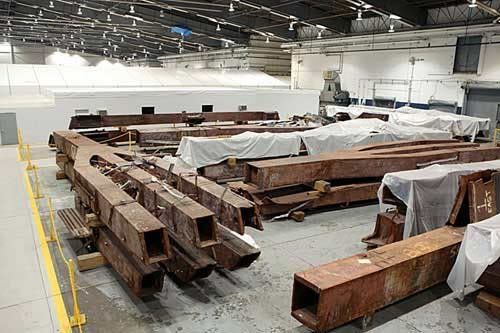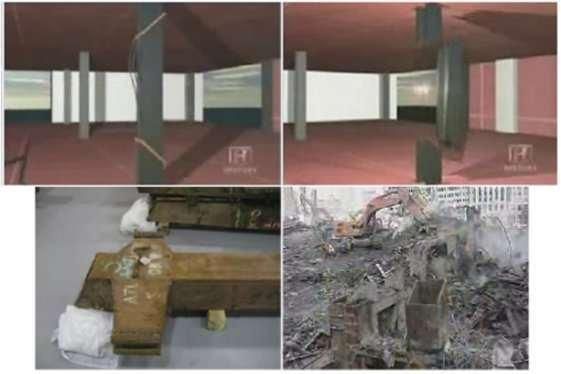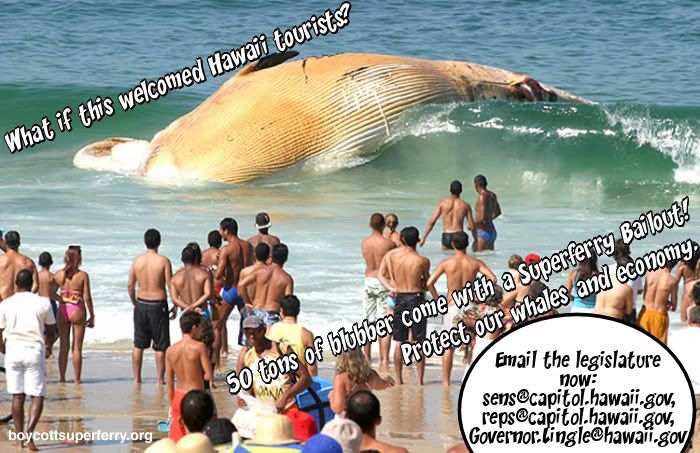 Molokai water meeting draws large crowdmahalo: JoshyboyDate: Aug 26, 2008 1:25 PMWater meeting draws large crowd
Molokai water meeting draws large crowdmahalo: JoshyboyDate: Aug 26, 2008 1:25 PMWater meeting draws large crowdBy Corinne Impey
8/21/2008 6:14:11 PM
Molokai News : Politics
Over 300 people gathered at the Mitchell Pauole Center Wednesday night for the first of what organizers say will be several meetings to address the Molokai water crisis.
Packing the seating areas both inside and outside the center, the audience was educated on the situation and encouraged to share their manao on where the community should go.
Walter Ritte, local activist, started the meeting by thanking everyone for attending.
“We are here tonight because we have to be part of the solution. The state tried to solve the problem and they screwed up,” he said.
Ritte highlighted some issues including the threat made by Molokai Ranch to end water service on Aug. 31 and the new utility rate increases approved by the Public Utility Commission.
He spoke of Governor Linda Lingle and said she has done nothing to help the situation. Rather, he said the community should rally behind the county of Maui.
Ritte’s statements were met with applause and shouts from the audience calling for council member Danny Mateo to become governor.
Catherine Mahealani Davis provided a presentation on the historical and current water situation on Molokai. She spoke of a time in the past when humans and the environment lived together in harmony.
But today, she said the island of Molokai is in an environmental crisis, including the west end.
“The Ranch’s lands are dying, it’s up to the citizens to save them,” she said.
A panel of local citizens and government officials then took the stage to answer questions.
On the panel sat Alton Arakaki, Walter Ritte, Mahina Martin from the office of Maui County Mayor Charmaine Tavares, council member Danny Mateo, Steve Morgan, Catherine Mahealani Davis, and DeGray Vanderbilt.
Much of the focus was on eminent domain with Mateo explaining that the first step in getting this process started is community support. Next, he said the Maui County Council would need to discuss the issue and make a resolution calling for eminent domain to be used. Mateo was unable to provide specific costs and time lines for the process. Eminent domain would involve the county or state stepping in to take over the Ranch’s land at a fair market price.
Ritte took an informal vote of the crowd asking who supported eminent domain. Over half of the attendees raised their hands. When asked who did not support eminent domain, no hands were raised.
Also available at the meeting were two petitions for residents to sign. The first was for gaining support towards eminent domain and the second was a petition to not support the “arbitrary, unjustified” utility rate increases.
Although many signatures were found on both petitions, Ritte explained that these petitions remain open for more support.
The next meeting that will be held to continue these discussions is a working meeting at Kulana Oiwi, Aug. 27 at 5 p.m.
According to Ritte, the two main issues that will be targeted are gathering legal advice to respond to utility rate increases and eminent domain.
For more meeting information see the next issue of The Molokai Times.
PUC: corrupt or just cluelessPUC: corrupt or just clueless
By Steve Morgan
8/20/2008 10:03:47 AM
Public Forum : Columns
View Comments Post Comment
In 2002 I took on the obligation of representing approximately 30 homeowners on the West End who were opposed to Molokai Ranch’s water rate hike. At that time we hired an attorney who had familiarity with the Public Utility Commission hearing process and filed for the position of “Opposing Party” on behalf of the West End homeowners. Our intent was to not only inspect the accounting practices of Molokai Ranch’s water system but to also inspect the physical properties of the system. Unfortunately, despite our efforts, we were denied the position of “Opposing Party” by the PUC and the end result was that no inspection of the Molokai Ranch water system ever took place, consequently, information that could have helped provide essential data in our current situation was denied.
Roll ahead six years to our current time and the story has again been repeated in duplicate. West Molokai Association recently chose to apply for opposition party status against the current PUC rate hike and again, position denied. Other than a quick review of basic accounting supplied by Molokai Ranch, no effort of any kind has been put into place by the PUC to inspect the operational and management practices of the Molokai Ranch water system.
Ignoring their own vested powers and moving ahead without any real evidence, the PUC along with the consent of Governor Lingle has given carte blanche to Molokai Ranch without holding any real torch of accountability under their ‘okole. This seems to follow in the footsteps that our government has set for many years now, whereas the interests of big business are given priority over the wellbeing of the consumer and ordinary citizen. Molokai Ranch has blatantly threatened to victimize our community and the PUC and the state government have awarded them by yielding to their demands.
Last week I took a quick look around the communities of Kaluakoi and Maunaloa to see if I could find any significant leaks or disrepair in the Molokai Ranch water system. Without even leaving my car, several major leaks were sighted, including two leaks in Maunaloa and four leaks in the Kaluakoi area. One massive leak located at Ahiu Road in Kaluakoi resembled a fresh water spring bubbling forth from the middle of the road. A friend who had brought this leak to my attention, noted that this leak had been ongoing for three to four years. My favorite leak however was found at Kaupoa just south of the old Ranch House. In an otherwise arid area, this leak has literally created what appear to be wetland taro patches. In one sense it brings a certain beauty to the place, and maybe I could appreciate this if I wasn’t so aware of who was really footing the bill for a leak of this size.
Why is it that this type of gross negligence goes unnoticed by the PUC? Instead of doing its due diligence, the PUC came to Molokai offering a mock hearing in which the PUC had already determined its outcome ahead of time.
It is time for the people of Molokai to say “no more” as these foreign companies and patronizing government institutions continue to make us the victims. It is time that the people of Molokai begin to seriously recognize our own responsibility of being the stewards of our own resources. Only when we finally assume this kuleana will the victimization stop.Condemning Molokai Ranch Lands - Eminent Domain BasicsAloha ko..u ..ohana,
In the near future, you'll probably be hearing more about the possibility of condemning Molokai Ranch's lands. This note is to give you a brief explanation of the concept and how it could work for Molokai.
Before the explanation, it’s important to know that the County of Maui has the authority to condemn the Ranch's lands all by itself. The County does not need the State’s authorization or support. And the process is surprisingly simple. It only requires the Maui County Council to pass a Resolution authorizing condemnation. A well-drafted Resolution and 5 out of 9 votes are all it would take to condemn the Ranch's lands! If you support this idea, your County leaders need to hear from you ASAP! Their e-mail addresses are at the end of this message.
And now for the explanation.
"Eminent domain" is the government's power to take private land for the benefit of the public. The process that the government uses to take the land is called "condemnation." Protection of the public's "health and safety" is the government's legal justification for condemning private land.
In the really bad old days, kings, czars and emperors could simply seize a person's land without paying for it. But today, our laws say that government cannot take private land without paying "just compensation" to its owner. So eminent domain is not a license to steal land! The easiest way to understand the concept is to think of eminent domain as a way for government to protect the public by forcing a private owner to sell their land at a fair price.
People in Hawai'i weren't thinking much about eminent domain until Governor Lingle proposed using this power to condemn the Turtle Bay resort on O'ahu's North Shore. After the initial shock wore off, the state Legislature decided to authorize condemnation of the Turtle Bay lands. The bill that authorized condemning Turtle Bay is attached to this message.There are two interesting things about this bill:
1) The Legislature's only "public health and safety" reason for condemning Turtle Bay is: “To protect and preserve Hawaii's historic and cultural heritage." Period.
2) The bill authorizes a 2-step purchase process. First, it authorizes the Governor to negotiate with the Turtle Bay owners to see if a sale can be finalized without the need for condemnation. During these negotiations, the Governor is allowed to work with potential private buyers who might be able to purchase some or all of Turtle Bay themselves, without any help from the government. Second, if negotiations don't work within a "reasonable time," then the bill authorizes the Governor to exercise the power of eminent domain and begin condemnation proceedings.
So how does this apply to Molokai Ranch? We all know that the Ranch's local management has insisted for a long time that the Ranch is not for sale. When they shut down operations in April, the Ranch said that it planned to "mothball" their properties until better times came along. Although the Ranch's top owner, Hong Kong’s Guoco Group Limited, might have private, more practical opinions about selling, their public position (via CEO Peter Nicholas) is that they don't plan to sell.
To justify condemnation, the government must find that there are compelling health and safety reasons in support of such a drastic action. In the case of Turtle Bay, the Legislature decided that it was enough to say that condemnation would protect Hawaii's cultural and historic heritage. That’s a pretty skimpy (though valid) justification.But boy does it ever pale in comparison to the reasons that Maui County has for condemning Molokai Ranch’s lands!
The most obvious justification for condemning the Ranch is its threat to shut down utility services to 1,200 customers. This is a huge threat to public health and safety. The Department of Health’s hearing officer said so formally in his August 14 order requiring the Ranch to continue providing water and sewer services. But the Ranch has not given anyone formal assurance that it plans to abide by the hearing officer’s order, and the order is only good for 90 days.
No developer in Hawai‘i’s history has ever made such a serious threat. Curiously, the State's response to this threat was to have the PUC unilaterally raise customer rates (without even being asked by the Ranch), and to have the Department of Health try to force Maui County to take over the Ranch’s utilities. Thanks to the PUC's decision, Molokai residents are now saddled with rate increases of up to 178%. And although the County successfully defended itself against the State’s efforts to rescue the Ranch, it will be required to provide emergency water service to the Ranch’s customers if the Ranch walks away after the DOH’s 90-day order expires.
Molokai Ranch is owned by a foreign company, Guoco Group, whose most recent business ventures are in international gambling.(See:
http://gambling. co. uk/news/gambling-news_11435_guoco-continues-with-rank-share-purchases. html) The Ranch is its only U.S. property. If the Ranch’s local management decides not to continue providing utility service after 90 days, there will be no way to fine or punish the top owners. The only leverage that our government has against this foreign company is its sole U.S. asset -- the Ranch’s 62,000 acres.
The Council could pass a resolution authorizing condemnation tomorrow (literally). If it chose to follow the Turtle Bay example, it could authorize Mayor Tavares to begin negotiations with the Ranch and potential private investors to arrange a sale at fair market value. If negotiations failed, the Council could then give the Mayor authority to exercise the power of eminent domain, in order to acquire the Ranch’s lands.Risk to taxpayers is minimal because:
1) The County would not need to put up any cash to start condemnation proceedings.
2) The process could be called off at any point if the County found that the Ranch’s threat to public health and safety was resolved.
To take this bold step, the County’s leaders need to know that they have the support of the Molokai community. Molokai’s Council member, Danny Mateo, said publicly last week that he is willing to pursue this option if the community supports it.Councilman Mateo, Mayor Tavares, and the rest of the Council need to hear from everyone! Here is a list of their e-mail addresses:
Mayor Charmaine Tavares
mayors.office@mauicounty.gov
Council Vice-Chair Danny A.Mateo
danny.mateo@mauicounty.us
Council Chair G.Riki Hokama
riki.hokama@mauicounty.us
Councilmember Michelle Anderson
michelle.anderson@mauicounty.us
Councilmember Gladys Coelho Baisa
gladys.baisa@mauicounty.us
Councilmember Jo Anne Johnson
jo_anne.johnson@mauicounty.us
Councilmember Bill Kauakea Medeiros
bill.medeiros@mauicounty.us
Councilmember Michael J.Molina
michael.molina@mauicounty.us
Councilmember Joseph Pontanilla
joseph.pontanilla@mauicounty.us
Councilmember Michael P.Victorino
michael.victorino@mauicounty.us
If you've made it this far, mahalo nui for your patience in reading this message. Molokai has fought hard to preserve its cultural and historical heritage for decades. Now is our chance to make our voices heard, and to move past the old battles to the huge task of restoring our island’s environment and economy. We can do it! But we need the County’s help to bring stewardship of the last Hawaiian island home from Hong Kong. And the County needs to know that we will stand behind them in this courageous endeavor.
I mua and Ho'i i ka Pono!
p.s.Here's the internet link to the County Code’s laws regarding condemnation: http://ordlink. com/codes/maui/index. htm When you get to the site, search for Ordinance Number 3.44.015 in the Index.
And if you want to read more about eminent domain, here are two more websites:
http://law. jrank. org/pages/6428/Eminent-Domain. html (pretty simple language)
http://caselaw. lp. findlaw. com/data/constitution/amendment05/14. html (seriously legal jargon)

 Answers to why the world is where it's at NOW and WHERE ITS GOING !MahaloHanalei
Answers to why the world is where it's at NOW and WHERE ITS GOING !MahaloHanalei




















 R.I.P Our Kupuna Out of the Ground!
R.I.P Our Kupuna Out of the Ground!
 THIS IS EXACTLY THE TYPE OF USA CORPORATE "MILITARY MEDIA SPIN USE FOR THEIR ILLEGAL ACTIONS !"despite last summer's rude, and even violent reception in Nawiliwili Harbor, the company remains hopefull it can one day resume service to Kauai."THEY BI~PASSED IMPORTANT LAWS SET IN PLACE TO PROTECT OUR AINA : "E.I.S." ENVIORNMENTAL IMPACT STATEMENTS !The Protesters were standing up & DEMANDING THE LAWS BE FOLLOWED!THIS SHOW JUST HOW MUCH THEY CARE ABOUT US AND OUR AINATO DEMONIZE THE ONES STANDING UP FOR THE LAW , THEIR AINA AND HOME!ALL THE WHILE BRIBING GOVERNMENT OFFICALS TO LOOK THE OTHER WAY AND THEN TO MAKE NEW SPECIAL LAWS DINGLE ~LINGLE'S REGIME~HEWA ~KU'E !Hawaii Superferry to get sister shipBy Howard Dashefsky, KHNLPosted: Aug 18, 2008MOBILE, AL (KHNL) - The future of sea travel in Hawaii is being built in Mobile, Alabama, by a company based out of Western Australia.A global leader in construction both commercial and defense vessels, the company named "Austal" is just months away from delivering Hawaii's second Superferry according to company representative Dietrich Giles."Most of the structure is complete at this point and a lot of the interior is coming together, what we call joiner work or walls have gone up and were putting coatings down and floor coatings and things like that", said Giles.The yet to be named vessel will feature a new color scheme, and more spacious common areas designed to be more user friendly for passengers.But the heart of the 350 foot vessel remains the same. A power train that generates 44 thousand horsepower, thanks to 4 hard charging German engines. But in today's economy, that power comes at a price according to the Alakai's" Chief Engineer."On a good day when we run at medium speed we burn about 550 to 6000 gallons of diesel" said Christian Yuhas."And on a heavy day when it's rough we have to go fast we burn more, about 8000".The new vessel will incorporate all the latest safety equipment and technology now found on the Alakai.It will also add a foldable ramp to assist in the loading, and off-loading of vehicles.The second ship will allow Superferry to begin offering service to the Big Island by next summer. And despite last summer's rude, and even violent reception in Nawiliwili Harbor, the company remains hopefull it can one day resume service to Kauai."I've been over to Kauai and talked to community leaders and business leaders and political leadership" said Superferry President Thomas Fargo."We're listening to their concerns, and hopefully we'll be able to move forward".
THIS IS EXACTLY THE TYPE OF USA CORPORATE "MILITARY MEDIA SPIN USE FOR THEIR ILLEGAL ACTIONS !"despite last summer's rude, and even violent reception in Nawiliwili Harbor, the company remains hopefull it can one day resume service to Kauai."THEY BI~PASSED IMPORTANT LAWS SET IN PLACE TO PROTECT OUR AINA : "E.I.S." ENVIORNMENTAL IMPACT STATEMENTS !The Protesters were standing up & DEMANDING THE LAWS BE FOLLOWED!THIS SHOW JUST HOW MUCH THEY CARE ABOUT US AND OUR AINATO DEMONIZE THE ONES STANDING UP FOR THE LAW , THEIR AINA AND HOME!ALL THE WHILE BRIBING GOVERNMENT OFFICALS TO LOOK THE OTHER WAY AND THEN TO MAKE NEW SPECIAL LAWS DINGLE ~LINGLE'S REGIME~HEWA ~KU'E !Hawaii Superferry to get sister shipBy Howard Dashefsky, KHNLPosted: Aug 18, 2008MOBILE, AL (KHNL) - The future of sea travel in Hawaii is being built in Mobile, Alabama, by a company based out of Western Australia.A global leader in construction both commercial and defense vessels, the company named "Austal" is just months away from delivering Hawaii's second Superferry according to company representative Dietrich Giles."Most of the structure is complete at this point and a lot of the interior is coming together, what we call joiner work or walls have gone up and were putting coatings down and floor coatings and things like that", said Giles.The yet to be named vessel will feature a new color scheme, and more spacious common areas designed to be more user friendly for passengers.But the heart of the 350 foot vessel remains the same. A power train that generates 44 thousand horsepower, thanks to 4 hard charging German engines. But in today's economy, that power comes at a price according to the Alakai's" Chief Engineer."On a good day when we run at medium speed we burn about 550 to 6000 gallons of diesel" said Christian Yuhas."And on a heavy day when it's rough we have to go fast we burn more, about 8000".The new vessel will incorporate all the latest safety equipment and technology now found on the Alakai.It will also add a foldable ramp to assist in the loading, and off-loading of vehicles.The second ship will allow Superferry to begin offering service to the Big Island by next summer. And despite last summer's rude, and even violent reception in Nawiliwili Harbor, the company remains hopefull it can one day resume service to Kauai."I've been over to Kauai and talked to community leaders and business leaders and political leadership" said Superferry President Thomas Fargo."We're listening to their concerns, and hopefully we'll be able to move forward".

 Super Ferry HawaiiSuper Ferry HawaiiHawaii Superferry and the Stewards of KauaiHAWAII SUPERFERRY WESTPAC EXPRESS SHIP
Super Ferry HawaiiSuper Ferry HawaiiHawaii Superferry and the Stewards of KauaiHAWAII SUPERFERRY WESTPAC EXPRESS SHIP

